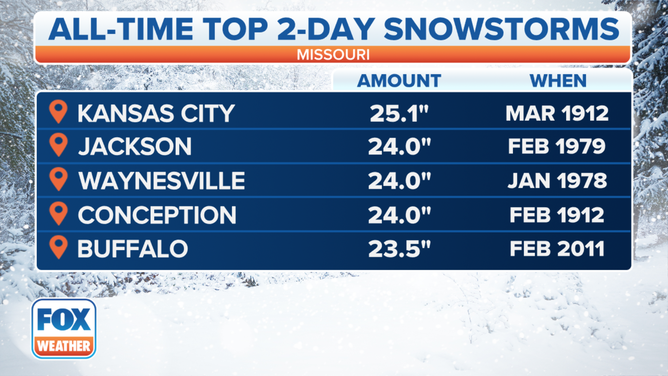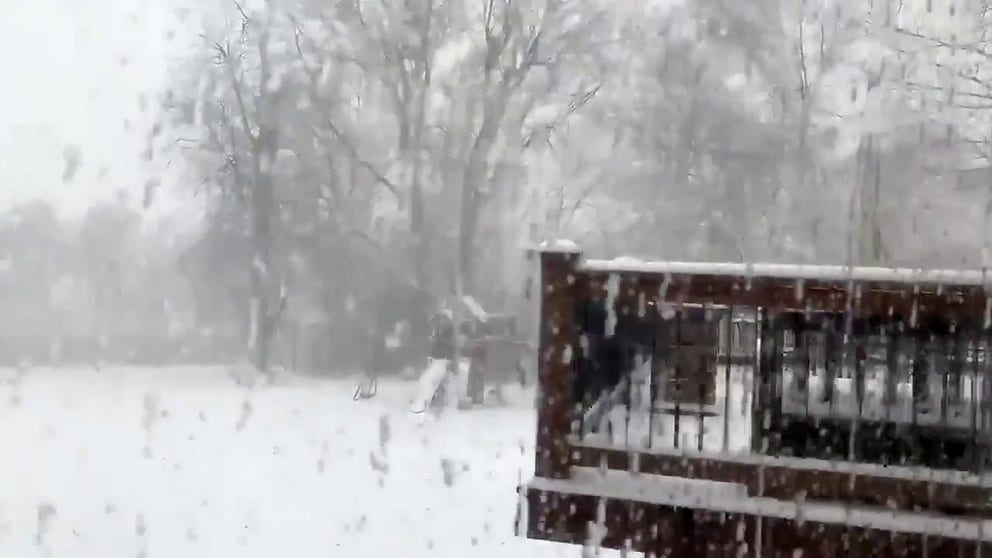Chilling stories of past Missouri winter storms illustrate importance of preparedness
Winter Weather Preparedness Week encourages you to prioritize safety and put a plan in place ahead of severe storms
A look back: Missouri, Kansas slammed by 2018 blizzard
A winter storm barreled over Kansas, Missouri and other Midwestern states on Sunday, Nov. 25, 2018, snarling traffic and forcing closures on highways and streets. This timelapse footage shows the snow piling up in the course of the day in Independence, Missouri.
JEFFERSON CITY, Mo. – While no one knows what this winter will bring, now is the time for people to plan ahead.
That's the message federal, state and local agencies across Missouri are sending to residents during Winter Weather Preparedness Week which is held Nov. 15-19.
They are encouraging everyone to prioritize safety and put a plan in place – both on the road and at home – ahead of the cold temperatures and potentially dangerous weather this winter.
Since 2018, Missouri has had six ice storms over the last 16 winters that were so severe they led to federal disaster declarations.
A 2009 ice storm in southeast Missouri downed about 18,000 utility poles and led to power outages that lasted up to two weeks for some residents.
Ten years later, Missouri Gov. Mike Parson encouraged people to brace for the bitter cold in January 2019 when areas of the state were expected to experience minus 40-degree wind chills for several days.

(FOX Weather)
WHAT DOES THE WIND CHILL MEAN?
In addition to frigid temperatures and snow and ice, winter in Missouri brings dangerous driving conditions and the potential for damaging and deadly storms.
According to Missouri’s State Emergency Management Agency, there were more than 5,500 vehicle crashes in the state last year in which snow or ice were factors. It resulted in 1,698 injuries and 26 deaths, according to the Missouri State Highway Patrol.
"Most Missourians have experienced frigid temperatures and icy road conditions, but many do not take the steps to prepare, so they don’t wind up getting stranded in the cold," State Emergency Management Agency Director Jim Remillard said.
In February 2019, a snowstorm caused a 15-vehicle pileup of cars, trucks and semi-trucks on Interstate 70 near Oak Grove. Another 47 vehicles were run off the road or damaged, resulting in one death and many more injuries.
Another 10 or so cars and trucks piled up, closing #highway70 west just west of the Concordia exit. I didn’t get all of the cars in the ditch on video. #missouri #weather #modot #70west @MoDOT pic.twitter.com/zceE8Dj2oa
— Kelly Dutton (@mskellydutton) February 15, 2019
According to the National Weather Service, the average winter snowfall in Kansas City (Oct.-April, 1981-2010) is 18.8 inches. The coldest temperature ever recorded was minus 23 degrees on Dec. 22 and 23, 1989.
A historic winter storm
One of the most historic events to impact the state was a three-day system known as the "Groundhog Day Winter Storm" from Jan. 31 to Feb. 2, 2011.
The winter storm produced crippling winter weather, including heavy snow and blizzard conditions, over a large area from the southern Plains through the middle and upper Mississippi Valley into the Great Lakes. Thundersnow was commonly observed during the storm from Oklahoma into Illinois.
Intense snowfall and blizzard conditions overwhelmed the infrastructure across portions of the nation’s midsection, leading to airport closures and hundreds of canceled flights, as well as the closure of portions of Interstate 70 across Missouri and Interstate 44 across southwest Missouri.
Heavy snow fell across central and northeast Missouri into west-central Illinois with rates at times exceeding 2 inches per hour. Snow drifts of 3 to 5 feet deep were observed.
The University of Missouri in Columbia canceled classes for two days due to the storm and its aftermath. Total snowfall accumulations along the corridor through Columbia and Jefferson City through Hannibal and Quincy ranged from 14-22 inches.
Snowy Missouri winters
Missouri has a trend of unusually mild winters and below normal snowfall.
This is something that has dulled residents' senses in regard to the severity and frequency of winter storms in the past, according to Patrick Guinan, a climatologist for the University of Missouri Extension,
"Historical snowfall data indicates Missouri’s snowiest periods occurred during the winters of 1911-12, 1959-60 and 1977-78," Guinan said.
During the winter of 1911-12, much of the state received more than 50 inches of snow and, for most locations, it still ranks as the snowiest winter on record.
"The largest snowfall totals that occurred from November 1911 through March 1912 were in northwestern Missouri where Maryville and Conception reported more than 6 feet of snow, 72.3" and 72.9", respectively," Guinan said.
Some Missouri cities that list the winter of 1911-12 as their snowiest winter include:
- Springfield – 54.3 inches
- Jefferson City – 64.5 inches
- Kansas City – 67.0 inches
- St. Louis – 67.2 inches
The majority of snow during this time occurred during February and March.
The frigid days of February
When looking back at Missouri's winter history, Guinan recalls the "Great Cold Wave of February 1899" which affected two-thirds of the United States.
"An Arctic air mass of Siberian origin moved southward out of Canada in late January and put most of the nation in an icy grip through mid-February," Guinan said.
February 8-12 still ranks as the coldest five-day outbreak on record for Missouri and many other states.
"It was so cold over the U.S. that ice flowed from the Mississippi River into the Gulf of Mexico, an occurrence that has happened only once, back in 1784," Guinan said.
The average statewide temperature in Missouri during this time was –6 degrees, nearly 40 degrees below normal. According to Guinan, an observer in Oregon, Missouri, stated the ground was frozen 2 to 3 feet deep.
Here are some winter weather preparations you can do now, plus advice to keep your families safe during inclement weather.
Create an emergency plan, kit
Emergency supplies should include bottled water, canned and dry foods, a battery-powered radio, flashlights, extra batteries, a manual can opener and a first-aid kit.
When power outages are possible, charge cell phones and other devices in advance, so you are able to communicate if power is lost.
A separate winter emergency kit for your vehicle should be assembled that includes a blanket, radio with spare batteries, snacks or energy-type food, jumper cables, flares, shovel and sand or shingles to give tires traction.
Avoid driving in poor conditions
Avoiding non-essential travel during winter storms is one of the best ways to reduce the chance of becoming involved in a crash or becoming stranded. If possible, you should postpone travel.
7 THINGS YOU NEED TO KNOW ABOUT WINTER DRIVING
However, if driving is necessary, make sure an emergency kit is in the vehicle, that your gas tank is more than half full, cell phones are charged and emergency numbers are saved for fast dialing.
You can check on road conditions in advance on the Missouri Department of Transportation’s Traveler Info Map.
Allow extra time, expect delays, reduce speed and increase following distance. Always drive based on conditions and not the posted speed limit.
If your vehicle breaks down or slides off the road, stay with your vehicle and call or wait for help. Even if not directly involved in a crash, an accident blocking the roadway could cause other drivers to be stranded for hours. It also allows snow removal crews to clear the roads faster and first responders to get to crashes more quickly.
Do alternate heat, power sources function properly?
Alternative heating and power sources include fireplaces, wood stoves, kerosene heaters and generators. If used improperly, these sources can be dangerous and must be maintained and operated safely.
You should keep the correct fuel for each source on hand in a safe location. Proper ventilation is essential, and generators should only be operated outdoors.
Carbon monoxide detectors should be properly installed throughout the home.
Space heater dangers
Space heaters account for about one-third of home heating fires and 80% of home-heating fire deaths annually.
These devices are supplemental heating sources and should be turned off when leaving a room or going to bed. Keep anything that can burn at least three feet from heating equipment.
You should never overload extension cords or electrical outlets. Spaces heaters should also never be used in place of a primary heating system.
Risks of exposure to cold temperatures
In 2020, 41 people reportedly died as a result of low body temperatures due to prolonged exposure to cold weather, according to the Missouri Department of Health and Senior Services.
7 WAYS TO PROTECT YOUR PETS DURING THE WINTER
You can protect yourself from frostbite and hypothermia by wearing warm, loose-fitting clothing in several layers. It is advised to avoid alcohol, limit time spent outdoors in frigid temperatures and stay indoors, if possible.
You can find the nearest warming center in Missouri at the DHSS website.
Make sure to send us your snow photos by using #FOXWeather on social media or emailing weather@fox.com.
